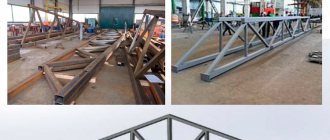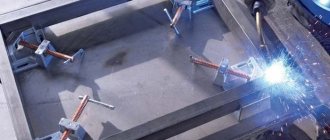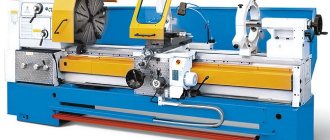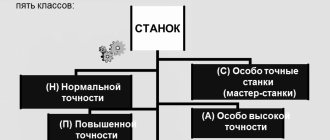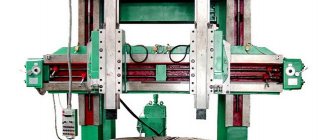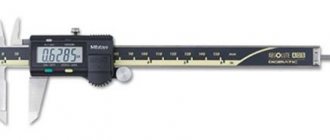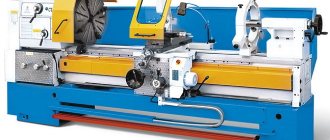The main task of any lathe is the mechanical processing of elements with a spherical, cylindrical, conical surface. With their help, it becomes possible to quickly and accurately cut any type of thread, perform drilling, boring, cutting, and trimming the end part of workpieces.
Modern equipment is highly functional. Manufacturers produce universal models and CNC machines. The second option has recently become increasingly popular due to the higher quality of technological operations.
Main types of lathes
All existing turning equipment can be divided into several groups according to the types of processed materials and parts.
Turning and screw-cutting equipment
Screw-cutting lathes belong to the category of universal units that are widely used in the manufacture of parts in a single copy or as part of mass production. The main task of the equipment is cutting inch, metric, and modular threads. It is also used to perform other metalworking operations.
The basis of the design of a screw-cutting lathe is:
- spindle head with gearbox;
- a frame on which the main structural elements of the equipment are mounted;
- a support designed to fix the cutting tool;
- an apron used to convert the movement of a screw or roller into movement in a given direction of the support;
- tailstock, necessary for fixing the workpiece in the optimal position (in most cases it is equipped with additional tools).
Show prices for screw-cutting lathes
Turret lathes
The turret group equipment is used for processing parts made from calibrated rods. With their help, you can perform a long list of technological operations. They include shaped turning, boring, reaming, threading, countersinking, and drilling.
The tools are mounted on the machine using a special holder. Depending on the modification of the equipment, it can be driven or static (the first option has greater functionality).
Show prices for turret lathes
Lathe units
The machines are used when it is necessary to process frontal, conical, cylindrical surfaces. Many models do not have a tailstock. An important feature of models of this type is the ability to process heavy parts of short length (this is possible due to the fact that the spindle rotates in a horizontal plane and the presence of sufficient free space). At manufacturing enterprises, when heavy loads are expected to be placed on the lathe, carousel units are used as a replacement.
Vertical lathes
The equipment is used to work with large-sized workpieces. Among their key features, it is worth highlighting the ability to:
- using the machine to form grooves of any configuration;
- thread cutting;
- turning conical or cylindrical surfaces;
- performing end cutting, milling, and grinding operations.
If the machine is equipped with additional equipment, it can be used to grind shaped surfaces using a copier.
During operation of the equipment, the workpiece is fixed on a faceplate, the diameter of which directly determines the overall dimensions of the unit. According to this parameter, there are single-post (up to 2000 mm) or two-post models (more than 2000 mm).
Show prices for rotary lathes
Turning and milling machining centers
The center is a multifunctional device with electronic programmable equipment and complex kinematics.
Models with vertical or horizontal spindle rotation are available.
In the first case, it is possible to process workpieces with high weight and size parameters. Such machining centers are equipped with an external cooling system, due to which the productivity of the machine is significantly increased by increasing the speed of rotation of the parts.
Most models with vertical spindle rotation have an automatic cutting tool change function. When positioned horizontally, centers are often equipped with tilt-rotary or rotary tables. Belt-type mechanisms are used to change tools.
Such machining centers are distinguished by the presence of a vibration damping system, the ability to use up to 120 tools in operation, thanks to the tracked mounting system.
Show prices for turning and milling machining centers
Automatic longitudinal turning
For small-scale production of parts, automatic longitudinal turning machines are widely used (equipment productivity can be up to 40 finished parts per minute). In this case, a shaped profile, wire, calibrated or cold-drawn rod can be used as blanks. There are models with movable and fixed spindle head.
Show prices for automatic longitudinal turning machine
Multi-spindle lathes
The equipment is used for processing workpieces with complex geometries, which are made from pipes, cold-drawn rods of any cross-section, as part of mass production.
High performance is ensured by high drive power.
When developing models of multi-spindle lathes, the use of structures of increased rigidity is envisaged. The equipment is capable of performing several technological operations simultaneously.
Show prices for multi-spindle lathes
CNC machines
Numerical control allows for high precision machining of workpieces and increased productivity. Automation of all processes greatly facilitates the operation of equipment.
Work processes are managed in one of three ways:
- contour (the machine operates continuously in accordance with the parameters specified by the user);
- along a rectangular contour (relevant when it is necessary to process step-shaped parts; the transverse and longitudinal transmission in them is switched automatically);
- positionally (in this case it is envisaged that the mechanism will initially be located at a given starting point, only after which processing begins).
CNC machine tools use self-adjusting, closed-loop or open-loop systems. They differ from each other in the principle of receiving information, reading and measuring mechanism.
Show prices for CNC machines
Pipe cutting units
The machines are highly specialized equipment used only for cutting steel pipes. They are widely used in geological exploration, gas and oil production, and other industries.
The operation scheme of CNC units is as follows: first, the workpiece is fixed in the chuck, then a program is installed for automated elimination of defects.
If it is necessary to perform additional operations, the machine is equipped with the required type of cartridges, a turret, and a cutter.
Show prices for pipe cutting units
Equipment with continuously variable drive
A feature of machines of this type is the ability to continuously change the spindle speed. With its help, it is possible to process both the external and internal surfaces of the workpiece.
Machines with stepless drives allow you to select the optimal speed mode at each stage of part processing.
Equipment with a continuously variable drive is characterized by consistently high reliability, ease of control, and long service life. Due to the absence of a gearbox, the machines have a relatively long overhaul interval. It is possible to adjust the spindle speed using hydraulics, as well as mechanically or electrically.
Bench lathes
A special table is used to install the equipment. Mini-machines are characterized by relatively small overall dimensions and weight.
They are used to process workpieces made of wood, metal, and plastic. Their main functions are boring, drilling, milling.
In most cases, equipment of this type is used for small-scale production or in private workshops. The machines are in demand due to their low cost and low energy consumption.
Show prices for benchtop lathes
Design Features
A screw-cutting lathe consists of standardized units and mechanisms that provide fixation and rotation of the workpiece, as well as the working movement of the cutter. Main components and parts of the equipment:
- bed;
- machine support;
- speed control box;
- headstock;
- tailstock;
- spindle;
- engine;
- equipment cabinets;
- guitar gears;
- feed selection and change box;
- apron;
- running roller;
- lead screw
It should be noted that the main components of screw-cutting lathes from different manufacturers have the same layout and similar names. In many cases they are identical and interchangeable.
Tips for choosing equipment
Metalworking machines
The choice of a metal cutting machine is always based on the characteristics of its future application. This is what its performance characteristics depend on (power, electrical parameters, list of available functions, accuracy, overall dimensions).
Particular attention should be paid to the following factors:
- Functional. It is worth considering in advance the list of technological operations that will be required to complete production tasks.
- Level of automation. The higher it is, the more expensive the equipment will be. But with an increase in the level of automation, the accuracy of the operations performed, their complexity and speed also increases.
- Tooling of the machine. It is important to take into account the minimum and maximum dimensions of the workpieces being processed, the amount of movement along the axes, the maximum diameter above the support and frame, and the spindle rotation speed.
- Software. When purchasing a CNC metalworking machine, the ability of the equipment to work in conjunction with other devices and its compatibility with CAD/CAM technologies becomes fundamentally important.
- Manufacturing company. When choosing any equipment, it is important that the manufacturer provides full warranty and service maintenance; during operation, there are no problems with the supply of components or consumables.
Machine for bending reinforcement (and cutting)
So-called bending machines are used mainly in construction, because very often you have to deal with reinforcement. It is used in concrete structures and many others. To pour reinforcement with concrete, it must be cut into certain pieces at a certain angle. A cutting machine is used for this.
Bending machines evenly bend the reinforcement. Without this special equipment, it is not only impossible to bend the reinforcement, much less do it evenly and evenly.
Woodworking machines
Modern manufacturers offer a wide selection of woodworking machines. General-purpose installations, special models for the production of similar parts, or specialized devices for certain types of wood processing are produced.
To ensure that the equipment fully meets your expectations after purchase, we suggest using the following tips.
- Optimal power depends on the characteristics of the work and the list of operations that will be performed on the selected machine. Household models are considered to be models with a power of up to 3 kW/h, connected to a 220 V network; industrial models are units with higher productivity, which are also distinguished by a greater depth of cut, planing width, and a wider range of functions.
- The bed should be heavy and rigid (cast iron would be the ideal material for its manufacture).
- It is desirable to have a chuck on the headstock or the ability to install it. In the future, this will make it possible to process workpieces that are secured at only one end.
- The ability to install a drill chuck on the tailstock, which will greatly facilitate the task of sharpening blind holes.
- The presence of a spindle speed controller is a convenient feature that will help improve the quality of many technological operations.
- Universal models are equipped with a saw blade, drill, milling cutter, planing shaft with 3 or 4 knives.
Regardless of the type of lathe chosen, its parameters and technical characteristics, special attention should be paid to the quality of its assembly and the manufacturer’s use of materials that can withstand the planned loads. Universal multifunctional modifications always become the optimal solution: with the help of such a machine it becomes possible to solve almost any problem in metal or wood processing.
Show prices for lathes
Main technical characteristics
All lathes of the turning group differ from each other in the following technical parameters:
- maximum spindle speed (the higher it is, the better the quality of surface treatment, the higher the cleanliness class);
- force on the shaft in various gears (this parameter depends on the power of the traction motor, so it is customary to talk about the total power of the machine);
- the maximum diameter of the workpiece being processed (the digital parameter in this case is an indicator of the height of the centers of the machine - the clamping points of the workpiece;
- an indicator of what type of machine it is (screw-cutting, turning-milling, face-to-face, etc.);
- presence and degree of automation (determined by the presence and “advancement” of a numerical control module).
In general, the main technical characteristics of a lathe can be gleaned from the markings on its nameplate (see the section “Notation systems and decoding”).
Classification of turning equipment
The classification system for this type of equipment was created in the USSR. According to these rules, machines are units that process metal workpieces, representing the first category. Any device from this group can represent one of the following groups:
- Devices with special purposes.
- Special purpose machines, conventional and automatic types.
- Polishing units with cutters.
- Frontal and screw-cutting types of equipment.
- Models of the “carousel” system.
- Machines that cut material.
- A variety called "revolver".
- Installations with a large number of spindles, fully or semi-automatic.
- Lathe-type units, where there is one spindle. Half automatic, fully automatic.
The following varieties are distinguished depending on the accuracy of processing:
- P – increased level.
- A – high accuracy rate.
- N – normal indicator.
- B – high level accuracy.
- C – special category accuracy.
Certain technical characteristics depend on one category or another. In addition, it becomes easier to determine the appropriate field of application. Marking devices also helps to find out what parameters are typical for a particular model. Such designations may consist of the following components:
- When using a unit as the initial form. It shows that the buyer is dealing with a lathe and not any other.
- Next comes a number indicating belonging to one or another type of model.
- The centers of the fixture have different heights, indicated by the third and fourth numbers.
The marking of units may also contain symbols in the form of letters. They are used to communicate certain design features. This applies to the following parameters:
- Equipped with a CNC system.
- The modification used.
- Fidelity of operations.
- How automated are the actions?
The letter “I” is used to designate devices with screw cutters. “P” – for high level accuracy. Such models are equipped with centers at a height of approximately 110 millimeters. Photos of products also help us understand what exactly is in front of us.


